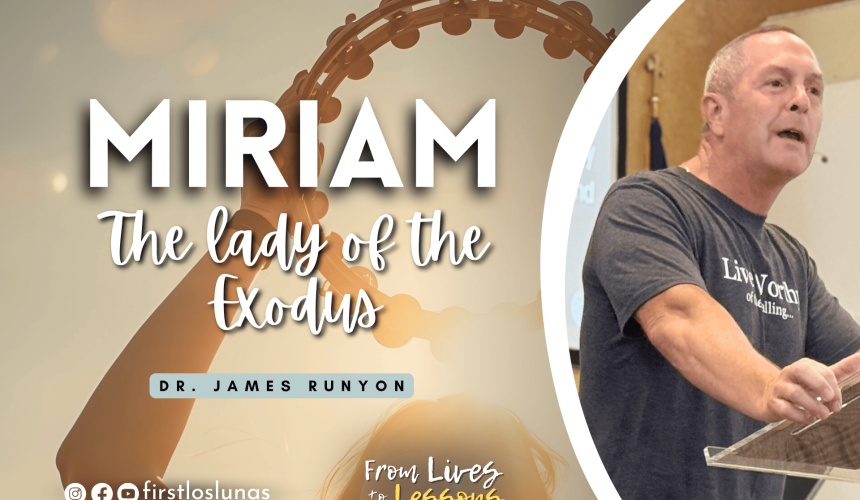Miriam – The Lady of the Exodus
Miriam stands as one of Scripture’s most remarkable women—a leader, prophetess, sister, and worshiper. Her life spans from the waters of the Nile to the songs of deliverance at the Red Sea. Through her story we see faith, courage, leadership, and even failure, all wrapped in God’s enduring mercy and faithfulness.
God’s Faithfulness Across Generations
Isaiah 46:4 – I will be the same until your old age, and I will bear you up when you turn gray. I have made you, and I will carry you; I will bear and save you.
From birth to old age, God promises His sustaining hand. Miriam’s story demonstrates that faithfulness—God carrying His people through every season of life.
The Greek form of the name Mary is Mariam, linking her name to later generations of women who would also bear great significance in God’s redemptive plan.
Exodus 1:8–10 – A new Pharaoh arose who did not know Joseph, bringing oppression to Israel and setting the stage for God’s deliverance.
Backstory: Watching the River
Exodus 1:22 – Pharaoh then commanded all his people: “You must throw every son born to the Hebrews into the Nile, but let every daughter live.”
In the midst of fear and cruelty, God was preparing a rescuer—and Miriam played a quiet but crucial role.
Exodus 2:3 – But when she could hide him no longer, she got a papyrus basket for him and coated it with tar and pitch. Then she placed the child in it and put it among the reeds along the bank of the Nile.
Exodus 2:9 – Pharaoh’s daughter said to her, “Take this baby and nurse him for me, and I will pay you.” So the woman took the baby and nursed him.
As a young girl, Miriam watched over her baby brother Moses as he floated down the Nile—faithfully guarding the one through whom God would deliver Israel.
Waiting for Deliverance
Miriam’s early faith grew into bold leadership. She waited for the fulfillment of God’s promises, and when deliverance came, she led the people in worship.
Worshiping at the River
Exodus 15:20–21 – Then Miriam the prophetess, Aaron’s sister, took a tambourine in her hand, and all the women followed her with their tambourines and danced. Miriam sang to them: “Sing to the Lord, for He is highly exalted; He has thrown the horse and its rider into the sea.”
Miriam’s song was the first recorded hymn of praise after Israel’s freedom. It celebrated God’s victory and inspired generations to worship through music.
-
Miriam the Prophetess – Numbers 12 identifies her as a prophetess, “one who speaks for God.” She was the first woman given this title in Scripture; only Deborah, Huldah, and Isaiah’s wife share it.
-
A Leader in the Exodus – Micah 6:4 – “Indeed, I brought you up from the land of Egypt and redeemed you from that place of slavery. I sent Moses, Aaron, and Miriam ahead of you.”
Miriam worked alongside her brothers Moses and Aaron, guiding and inspiring the people. -
A Worship Leader – Her singing rallied the women to praise God. Her song centered on His power and glory, setting an example for Israel’s future worshipers.
1 Samuel 18:6 – As the troops were coming back, when David was returning from killing the Philistine, the women came out from all the cities of Israel to meet King Saul, singing and dancing with tambourines, with shouts of joy, and with three-stringed instruments.
Weakness in the Wilderness
Numbers 12:2 – They said, “Does the Lord speak only through Moses? Does He not also speak through us?” And the Lord heard it.
Even faithful servants can falter. Miriam and Aaron challenged Moses’ authority, forgetting that leadership flows from God’s calling, not human ambition.
Numbers 12:6–8 – He said, “Listen to what I say: If there is a prophet among you from the Lord, I make Myself known to him in a vision; I speak with him in a dream. Not so with My servant Moses; he is faithful in all My household. I speak with him directly, openly, and not in riddles; he sees the form of the Lord.”
God gently yet firmly reminded them that Moses had a unique role—but He did not discard Miriam. His correction was redemptive, not destructive.
Micah 6:4 again honors her as one of the three leaders God sent to guide His people from bondage to freedom.
Final Reflection
Miriam’s life mirrors the journey of God’s people—protected in youth, bold in faith, humbled in failure, and restored in grace. Her legacy as a prophetess and worshiper reminds us that true leadership begins with trust in God and ends with giving Him all the glory.

